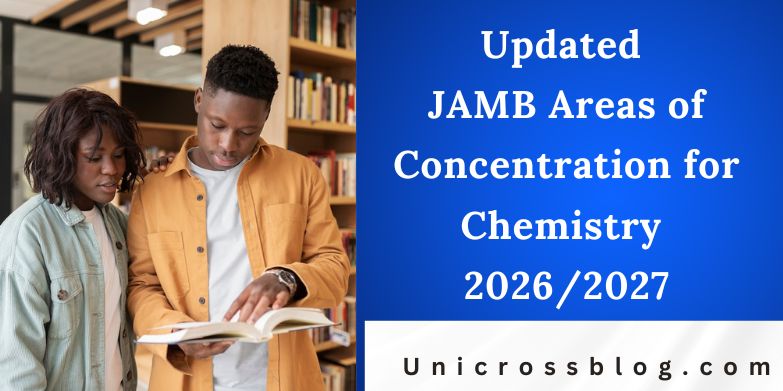Preparing for the JAMB UTME Chemistry exam requires a focused approach on the key topics outlined in the official syllabus. The areas of concentration for Chemistry in the 2026/2027 session remain consistent with recent years, emphasizing foundational concepts in physical, inorganic, and organic chemistry. These topics are designed to test your understanding of matter, its properties, reactions, and applications. By concentrating on these areas, you can efficiently allocate your study time and improve your chances of scoring high.
The syllabus covers 15 main sections, each with specific subtopics and objectives. Aim to master definitions, principles, calculations, and practical applications. Practice with past questions to identify patterns. Below is a detailed breakdown of the areas of concentration, including what you should know and be able to do.

JAMB Areas of Concentration for Chemistry
1. Separation of Mixtures and Purification of Chemical Substances
Focus on methods for separating components of mixtures based on physical properties. Key topics include filtration, evaporation, distillation (simple and fractional), crystallization, chromatography (paper, column, and gas-liquid), and sublimation. Understand the principles behind each method, such as differences in boiling points or solubility. Be able to describe the separation of mixtures like ink, salt from sand, or petroleum fractions. Objectives: Identify suitable separation techniques for given mixtures and explain their limitations.
2. Chemical Combinations
This area deals with the laws governing how elements combine to form compounds. Study the law of conservation of mass, law of definite proportions, law of multiple proportions, and Avogadro’s hypothesis. Include calculations involving relative atomic mass (RAM), relative molecular mass (RMM), and vapour density. Objectives: Solve problems on chemical combinations and demonstrate how these laws apply to real-world reactions, such as combustion or synthesis.
3. Kinetic Theory of Matter and Gas Laws
Explore the behavior of gases and the particulate nature of matter. Cover assumptions of the kinetic theory, diffusion (Graham’s law), Boyle’s law, Charles’ law, Dalton’s law of partial pressures, Avogadro’s law, and the ideal gas equation (PV = nRT). Include calculations for gas volumes, pressures, and temperatures. Objectives: Predict gas behavior under changing conditions and explain phenomena like effusion or Brownian motion.
4. Atomic Structure and Bonding
Understand the structure of atoms and how they bond. Topics include subatomic particles (protons, neutrons, electrons), atomic number, mass number, isotopes, electron configuration, and orbitals (s, p, d, f). Cover types of bonds: ionic, covalent (polar and non-polar), coordinate, metallic, and intermolecular forces (van der Waals, hydrogen bonding). Discuss hybridization (sp, sp2, sp3) and VSEPR theory for molecular shapes. Objectives: Draw electron dot structures, predict bond types, and explain properties like conductivity or melting points.
5. Air and Combustion
Examine the composition of air (nitrogen, oxygen, noble gases, CO2, water vapor) and combustion processes. Include laboratory preparation and properties of oxygen, oxides (acidic, basic, amphoteric, neutral), and carbon (diamond, graphite, fullerenes). Study complete and incomplete combustion, with calculations for calorific values. Objectives: Describe tests for gases (e.g., limewater for CO2) and analyze environmental issues like acid rain or greenhouse effects.
6. Periodic Table and Periodicity
Master the modern periodic table, including periods, groups, and trends: atomic size, ionization energy, electron affinity, electronegativity, and metallic/non-metallic character. Focus on s, p, d, and f blocks, with examples of alkali metals, halogens, and transition elements. Objectives: Predict properties of elements based on position and explain anomalies like the inert pair effect.
7. Chemical Families: Groups I to V
Study the chemistry of specific groups. Group I (alkali metals: Li, Na, K; reactions with water, oxides, hydroxides). Group II (alkaline earth metals: Mg, Ca; properties of compounds like Plaster of Paris). Group III (boron family; amphoterism). Group IV (carbon family; allotropes, catenation). Group V (nitrogen family; Haber process, ammonia properties). Objectives: Outline preparation, properties, and uses of key compounds, such as NaOH or NH3.
8. Chemical Families: Groups VI to VII and Zero
Cover Group VI (oxygen family: O2, S, SO2; contact process for H2SO4). Group VII (halogens: Cl2, Br2, I2; displacement reactions, bleaching). Group Zero (noble gases: occurrence, uses like helium in balloons). Objectives: Explain reactivity trends and industrial applications, such as electrolysis of brine for NaOH and Cl2.
9. Metals and Their Compounds
Discuss extraction of metals (e.g., iron from hematite via blast furnace, aluminum via electrolysis). Include ores, calcination, roasting, and refining. Study properties of metals (malleability, ductility) and alloys (steel, brass). Objectives: Describe corrosion prevention (galvanizing) and economic importance of metals in industries.
10. Organic Compounds: Introduction
Introduce hydrocarbons: alkanes (paraffins, e.g., methane), alkenes (olefins, e.g., ethene), alkynes (acetylenes, e.g., ethyne). Cover isomerism (structural, geometric), IUPAC nomenclature, and homologous series. Include sources like petroleum (fractional distillation, cracking). Objectives: Name compounds, draw structures, and explain cracking for fuel production.
11. Organic Compounds: Functional Groups
Focus on alcohols (primary, secondary, tertiary; fermentation, oxidation to aldehydes/ketones/carboxylic acids), carboxylic acids (ethanoic acid, esters via esterification), and fats/oils (saponification). Include carbohydrates (monosaccharides like glucose, tests with Benedict’s or Fehling’s solution). Objectives: Identify functional groups and perform reactions like hydration or ester hydrolysis.
12. Organic Compounds: Polymers
Understand addition polymers (polyethene, PVC) and condensation polymers (nylon, polyesters). Cover natural polymers (proteins, starch) and plastics recycling. Objectives: Differentiate polymerization types and discuss environmental impacts.
13. Rates of Chemical Reactions
Study factors affecting rates: concentration, temperature, surface area, catalysts (homogeneous, heterogeneous), and pressure for gases. Include collision theory and activation energy. Experiments: reaction between HCl and Na2S2O3 or marble chips. Objectives: Interpret rate equations and use graphs to analyze data.
14. Energetics and Thermodynamics
Cover exothermic/endothermic reactions, enthalpy changes (ΔH), bond energies, Hess’s law, and standard conditions. Include calorimetry for heat of neutralization or combustion. Objectives: Calculate ΔH values and predict reaction feasibility using energy diagrams.
15. Chemical Equilibria
Discuss reversible reactions, Le Chatelier’s principle, equilibrium constants (Kc, Kp), and Haber process optimization. Include acid-base equilibria (pH, buffers) and solubility product. Objectives: Predict shifts in equilibrium and solve problems on Ksp.
16. Non-Metals and Their Compounds
Examine hydrogen (preparation, isotopes), oxygen compounds, nitrogen (fixation), sulphur (Vulcanization), and chlorine (disinfectants). Objectives: Outline industrial processes like Ostwald for HNO3.
17. Redox Reactions
Understand oxidation numbers, balancing redox equations (half-equations), and electrochemical cells (Daniel cell). Include applications in batteries and corrosion. Objectives: Identify oxidizing/reducing agents and calculate cell potentials.
18. Electrochemistry
Cover electrolytes/non-electrolytes, Faraday’s laws, electrolysis (e.g., of NaCl, CuSO4), and factors affecting ion discharge. Objectives: Calculate quantities from electrolysis and explain products at electrodes.
19. Chemical Industries
Focus on processes like petroleum refining, fertilizers (urea), and pharmaceuticals. Discuss raw materials, unit operations, and quality control. Objectives: Evaluate economic and environmental aspects of industries.
20. Environmental Chemistry
Address pollution (air, water, soil), greenhouse gases, ozone depletion, and waste management. Include green chemistry principles. Objectives: Propose solutions to issues like oil spills or eutrophication.
In total, these areas encompass about 40 questions in the exam, blending theory, calculations, and applications. Dedicate time to weak spots, such as stoichiometry or organic nomenclature, and review regularly.
READ ALSO: Updated JAMB Areas of Concentration for History 2026/2027
FAQs
How many questions come from Chemistry in JAMB UTME?
Typically 40 multiple-choice questions, lasting about 40 minutes within the overall exam time.
Is the 2026/2027 syllabus different from previous years?
No major changes; it builds on the 2025 version with the same core topics for consistency.
What calculations should I practice most?
Gas laws, mole concepts, percentage yield, equilibrium constants, and redox balancing.
How do I prepare for practical aspects without a lab?
Use diagrams and videos to visualize experiments like electrolysis or titrations; focus on observations and principles.
Are organic chemistry topics heavily tested?
Yes, especially hydrocarbons and functional groups; expect 8-10 questions on naming and reactions.
What if I forget formulas during the exam?
Memorize key ones like PV=nRT or ΔH = bonds broken – bonds formed; practice deriving others.
Can I use calculators in JAMB Chemistry?
No, so sharpen mental math for quick conversions and percentages.
Is environmental chemistry a new focus?
It’s growing, with questions on sustainability and pollution control.







